Using the data compiled from the Alphacool ST30 thermal testing I have compiled the following tables in an attempt to show other ways of how the ST30 performance varies against itself at the flow rates and fan speeds tested. First let’s take a look at the raw W/10DT numbers we will be using to generate these comparisons:
Effectively these show percentage gains relative to a reference point. It’s an interesting way to show gains/losses while changing a variable. This first table shows performance gain or loss relative to 1.0GPM flow rate:
We can also focus on 1300RPM as our reference and see how much gain or loss in performance we get by changing fan speed:
As expected the change is dramatic. How about we combine both flow rate and fan speed as reference points and have a look at 0.5 GPM & 750 RPM as the reference point.
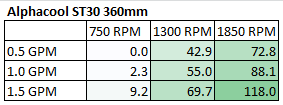 Lastly, we change the reference and choose our centre 1300 RPM and 1.0 GPM as our reference point to show both effects concurrently:
Lastly, we change the reference and choose our centre 1300 RPM and 1.0 GPM as our reference point to show both effects concurrently:
So from the data above we can get a very good idea of how the ST30 radiator performs relative to itself. But there is a large selection of 360mm radiator models to choose from, released from numerous manufacturers. So, we need to start comparing performance between them.
Push Only Data vs Competition
Let’s focus on the Push Only results for now and come back to the Push/Pull data later. While for Push/Pull we tested three flow rates, the Push Only testing was conducted only at 1GPM in order to save time. For a comparison vs thicker radiators make sure to check out the 2015 Rad Round Up which compares 27+ radiators including the ST30.
Let’s start with 750 RPM and see how it compares to the competition:
At 750RPM the slim ST30 does well in the comparison and places 2nd among the test group, ~8% behind the winner. However if you compare to the leading slim radiator (the HWLabs GTS) then the performance looks less compelling.
At 1300 RPM the ST30 drops a few spots and is now 10% behind the GTS
At 1850RPM the trend continues which confirms our assessment made in earlier that it’s performance dropped off as the fan speeds increased.
So the ST30 was a decent performer in Push Only which good because is the most likely installation scenario for this radiator. It appears to be better tuned for low fan speeds than most of the competition, but doesn’t fall too far behind with increased fan speeds.
Even though Push/Pull fan assemblies are probably not what the intended use for a slim rad actually is (for most users) we tested it anyway.
So let’s find out how it fared…..
Push/Pull Data vs. Competition
Let’s now look at the Push/Pull results and see how the ST30 360 compares. For Push/Pull we have averaged the results from the 3 flow rates at which we tested.
At 750RPM the ST30 again starts off quite well again placing 2nd. It’s even closer to the GTS this time too. It seems like the Alphacool radiators including the ST30 do benefit more from low speed push/pull than their competitors.
At 1300 RPM the ST30 has fallen behind the leaders
At 1850RPM it falls slightly further again..
Let’s also combine the Push Only and Push/Pull results at the 1.0 GPM flow rate into one plot for each fan speed tested. These plots show just how well the best slim radiators performed against the competition, while showing the ST30’s half decent performance.
Again the 750 rpm first:
At 750 RPM we can see the ST30 would be a great choice – if it weren’t for the GTS. Never the less the ST30 is still a good choice then in terms of space efficiency at low fan speeds.
At 1300 rpm the ST30 is still has OK performance for a slim rad, but it does fall a behind the competitor’s performance as the fan speeds increase, so there are definitely better performance options available.
At 1850 rpm the ST30 no longer seem OK, placing 5th in both Push and Push/Pull assemblies.
From all of test results we created “Average Performance Factor” charts for both Push and Push/Pull and then a combined plot called the “Master Performance Factor”. The radiator with the best cooling ability (W/10ΔT) at each gpm/rpm combo was awarded a score of 100, and each other radiators W/10ΔT result was scored as percentage of the top performer.
This way of looking at the comparison takes away any advantages that a radiator may have at higher or lower fan speeds and looks at an overall average. While this appears fair it does tend to favor those radiators that are all-rounders and those radiators which do very well at high RPM. Most users should be more focused on their specific use case. Check in the Round Up for performance comparisons at every gpm/rpm combo for even more details and cross comparison results.
Here is the ST30’s Push/Pull percentage scores at each data point that thermal tests were conducted at and additionally the 1.0 gpm Push Only percentages relative to the winner at each fan speed.
So looking at these percentages comparatively, we see that the ST30’s performance get’s noticeably worse against the competition as the fan speed is increased. It is a small test group, and it is clear that there was at least one among the test group which did really well with high speed fans for the ST30’s results to be so much in the red. This table also indicates that the ST30 was getting better performance as the flow rate was increase compared to the others.
Then we started averaging the percentage scores at each flow rate giving us the Averaged Performance Factors of each radiator.
Firstly – the Push Only APF:
In Push Only the ST30 finishes in 4th place by the slimmest of margins. It is clear that 4 of the slim rads all had similar performance , while there was one clear winner and one clear loser.
In Push/Pull the ST30’s performance gained ground on the winning rad, but so did it’s rivals, so the ST30 place 5th.
Finally we created the Master Performance Factor which is calculated from the averaged results of all the thermal tests, Push and Push/Pull at all flow rates and all fan speeds.
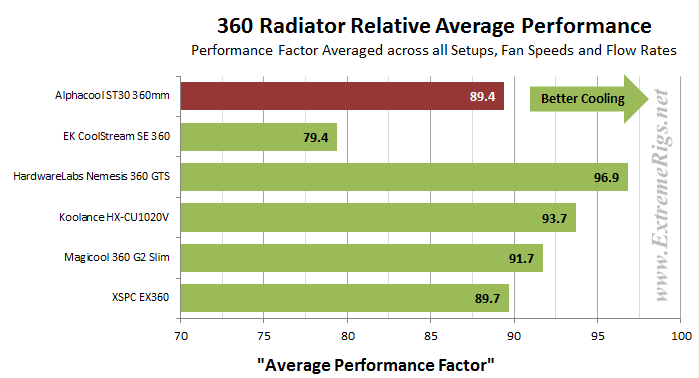 In the Master Performance Factor comparisons the ST30 360 finishes in 5th place, or second last
In the Master Performance Factor comparisons the ST30 360 finishes in 5th place, or second last
Next up – Summary!







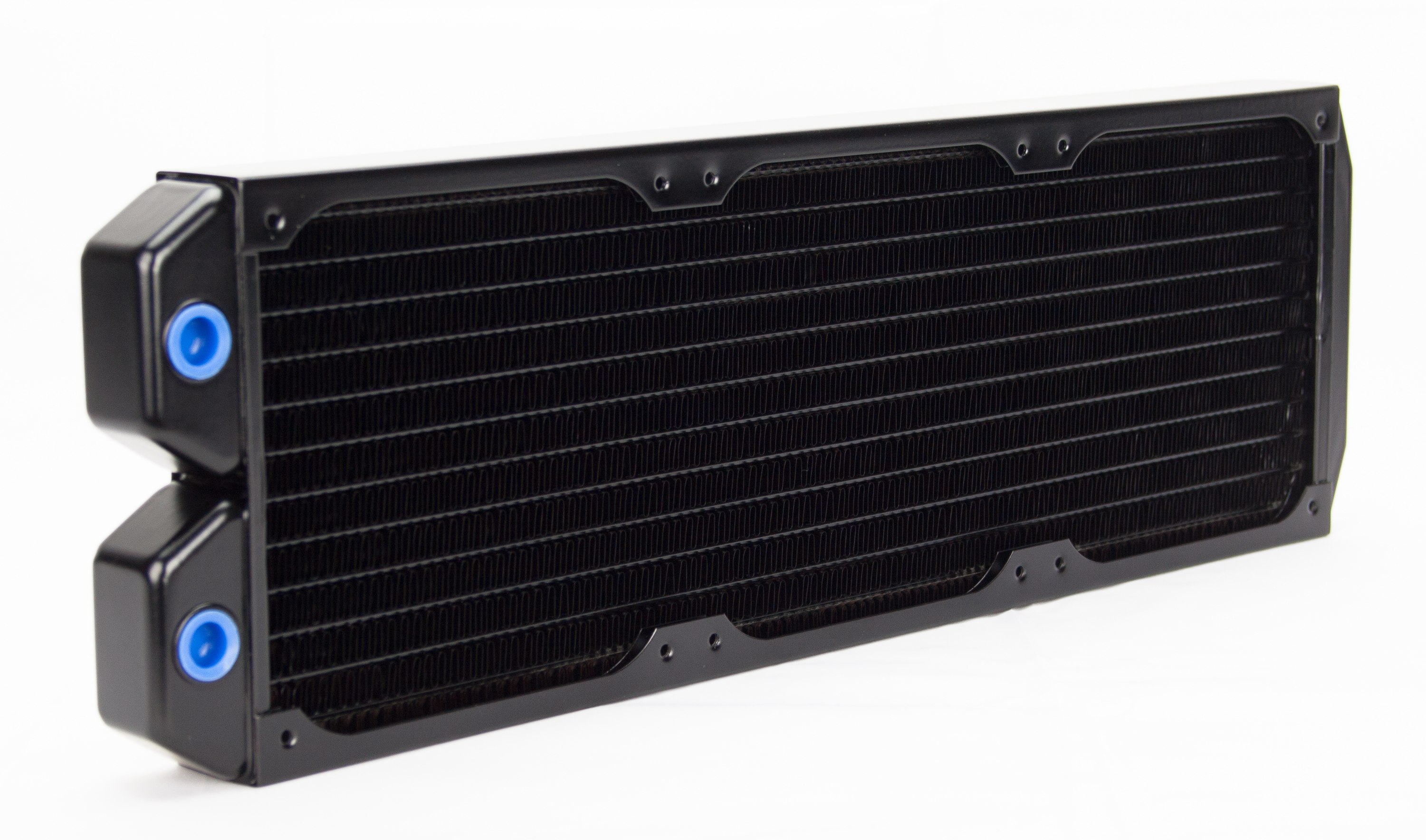
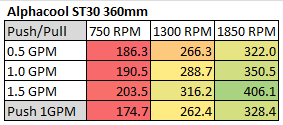
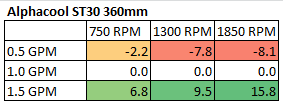
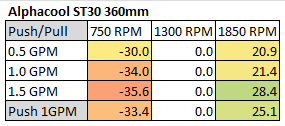
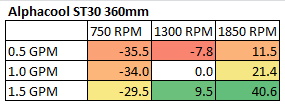
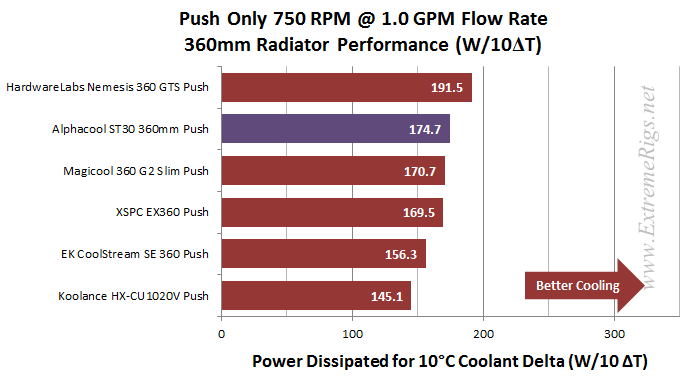
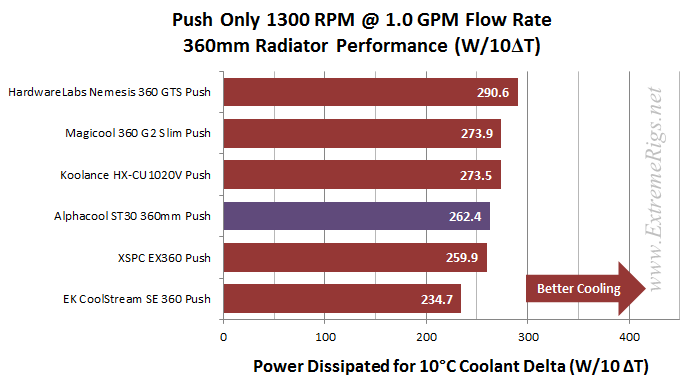
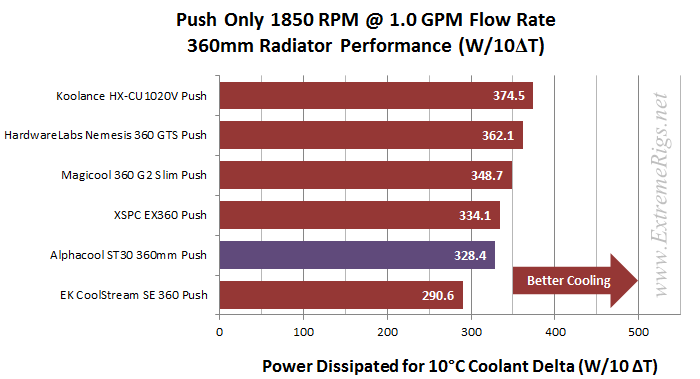
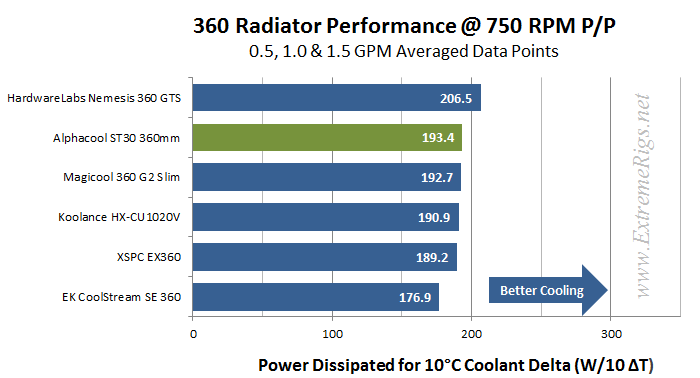
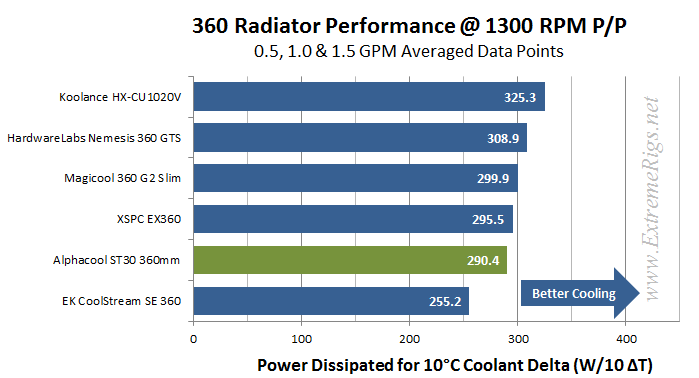
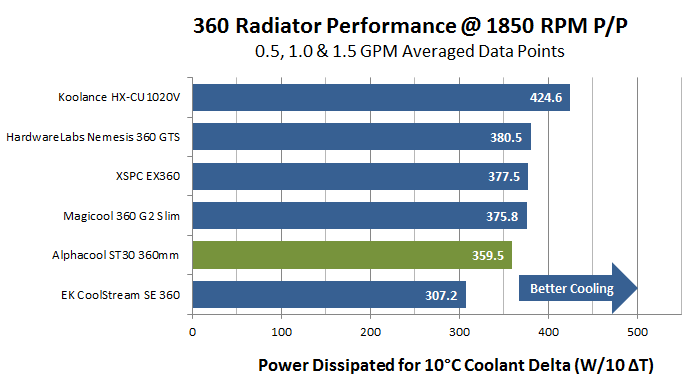
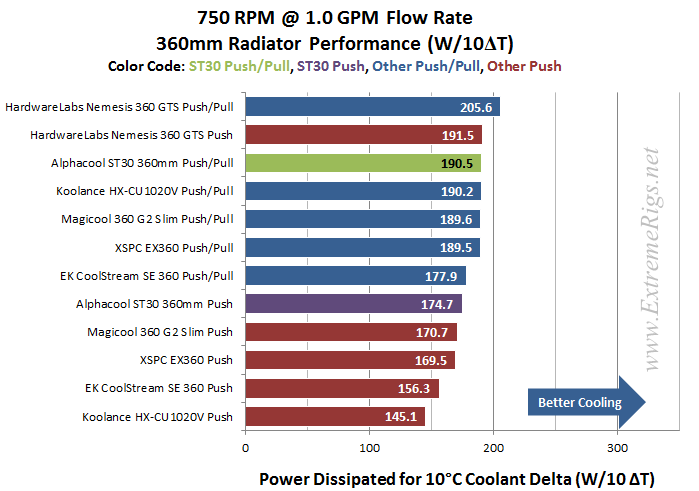
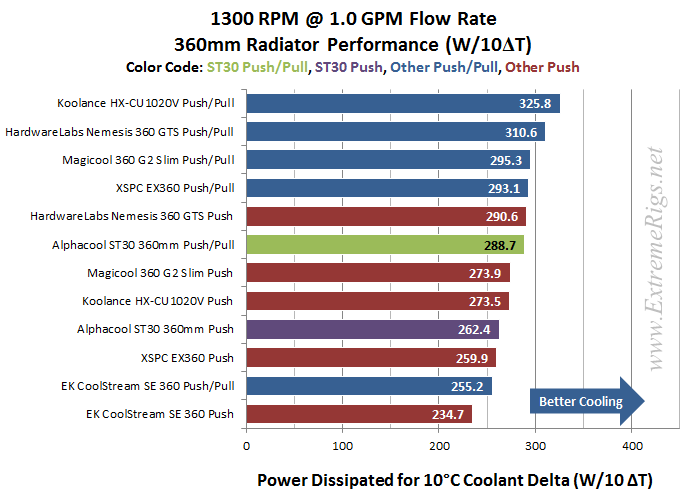
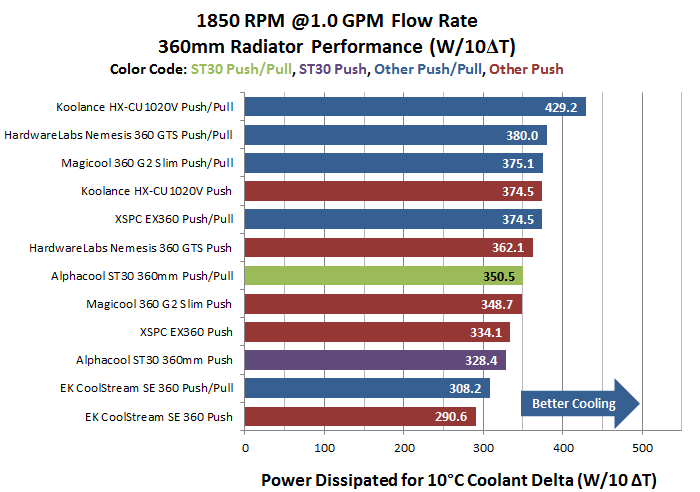
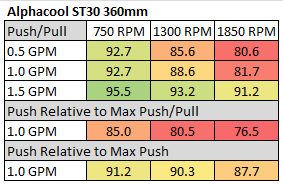
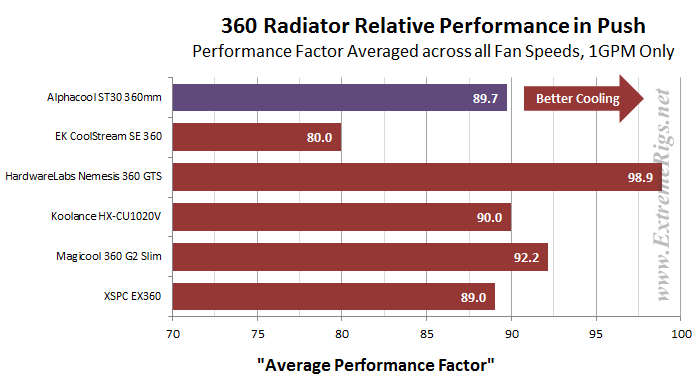
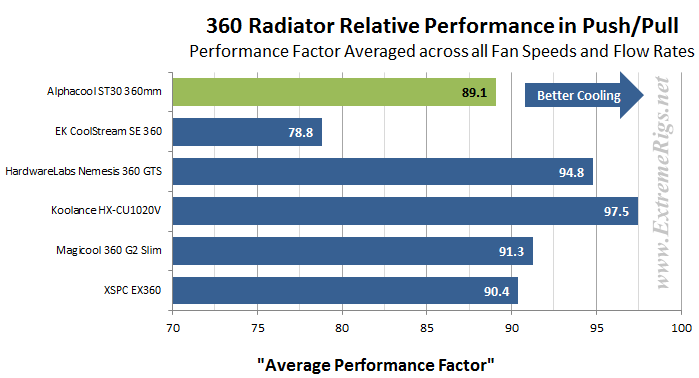



[…] Monsta 360 Radiator Alphacool ST30 360 Radiator AquaComputer Airplex Radical Copper 360 Radiator AquaComputer AMS 360 Radiator Coolgate CG 360 […]
[…] ,finde ich den artikel von xtremerigs.net sehr interessant … im Vergleich nexxxos st30 und ut60: Alphacool NexXxos ST30 360 Radiator Review – Page 4 of 6 – ExtremeRigs.net Alphacool UT60 360 Radiator Review – Page 4 of 6 – ExtremeRigs.net da sieht man schon, dass […]
[…] interesting reference for some readers/potential buyers will be our review of the ST30 360mm which we published last year. While not a true 1:1 comparison because of the different […]
The ST30 looks fine for slower/medium speed fans of around 1,000RPM or below? Seems like it’s underrated if you ask me looking at those results..
Comments are closed.